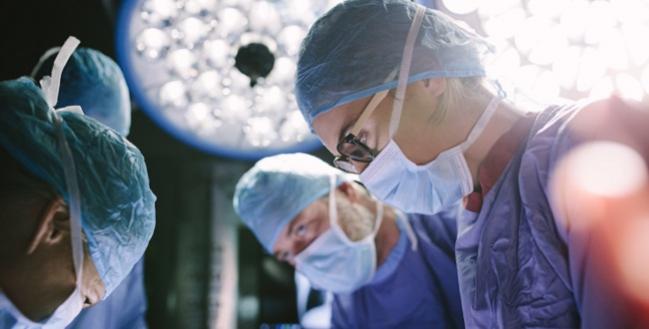Unrecognized Obstructive Sleep Apnea Linked to CV Complications After Noncardiac Surgery
In the POSA study, those with severe sleep apnea had a twofold risk of postoperative events at 30 days.

Obstructive sleep apnea (OSA) appears to be independently associated with adverse cardiovascular outcomes in patients undergoing noncardiac procedures, results from the POSA study suggest. Giving supplemental oxygen in the postprocedural period did not reduce the 30-day rate of complications in those at highest risk.
OSA is known to increase risk for cardiovascular events over time, but whether the condition impacts surgical situations is unclear. Existing studies have yielded conflicting results and been primarily retrospective, Matthew T. V. Chan, MBBS, PhD (Chinese University of Hong Kong), said in an email. “Furthermore, the majority of patients presenting for surgery do not have sufficient time for detailed sleep studies, and therefore a large proportion of patients [are] unrecognized and untreated for OSA,” he added.
In the study, known as POSA, Chan and colleagues found that two-thirds of patients given sleep tests prior to a noncardiac surgery had unrecognized OSA, while about one in 10 had severe OSA. Patients in the latter group had a twofold greater risk of postoperative cardiovascular complications, including death and MI, than those without OSA.
“Now that we have this high-quality evidence showing an association, the question is whether treatment [for OSA] would make any difference,” Babak Mokhlesi, MD (University of Chicago, IL), who was not involved in the study, commented to TCTMD. “That’s the part that remains unknown. And, if treatment is going to make a difference, what kind of treatment is best? It could be oxygen, it could be [continuous positive airway pressure (CPAP)], or more mechanical interventions, like keeping the head of the bed elevated to minimize obstruction of the upper airway, or an oral appliance.”
Wide Range of Adverse Events Seen
Published online today in JAMA, the multicenter POSA study included 1,218 patients with one or more risk factors for postoperative cardiovascular events who had a preoperative overnight sleep study either at home within a month of surgery (34.6%) or in the hospital on the night before their scheduled procedure (65.4%). Noncardiac procedures included intraperitoneal, orthopedic, vascular, and cancer surgeries. Severity of OSA was rated via the STOP-Bang questionnaire and showed that 26.3% of the population was at high risk for severe OSA.
Now that we have this high-quality evidence showing an association, the question is whether treatment [for OSA] would make any difference. Babak Mokhlesi
In further, post hoc analyses, severe OSA was also associated with cardiac death (adjusted HR 13.66; 95% CI 1.63-114.19), myocardial injury (adjusted HR 1.80; 95% CI 1.17-2.77), congestive heart failure (adjusted HR 6.55; 95% CI 1.71-25.06), and A-fib (adjusted HR 3.96; 95% CI 1.24-12.60). Patients with OSA also were more likely than those without OSA to experience infective outcomes, unplanned tracheal intubation, postoperative lung ventilation, and ICU readmission.
To TCTMD, Chan said patients with severe OSA should be closely monitored after surgery and appropriate treatment such as CPAP should be instituted to prevent severe oxygen desaturation. Due to the limited availability of sleep studies, he added, “we believe patients will need to be routinely assessed with the STOP-Bang screening tool. In our study, patients with five or more of the risk factors already put them into a higher risk for postoperative cardiovascular complications (1.7-fold).”
OSA: An Important Disease Complex and Comorbidity
In an editorial accompanying the study, Dennis Auckley, MD (Case Western Reserve University, Cleveland, OH), and Stavros Memtsoudis, MD, PhD (Weill Cornell Medical College, New York, NY), say the time has come for OSA and its associated disease processes to be recognized as major perioperative risk factors.
“OSA as a disease complex should receive the same attention as other comorbidities, such as diabetes, for which optimization has improved perioperative morbidity and mortality over recent decades,” they write.
But the issue is not an easy one to address, especially since many people with OSA have other comorbidities, such as obesity and hypertension, that contribute to their increased risk of cardiovascular events, making it difficult to parse out the true clinical impact of OSA, said Mokhlesi.
Chan and colleagues call for randomized trials to see if CPAP, prolonged oxygen therapy, or more-intensive monitoring can avoid cardiovascular complications.
“Most reasonable people would say we should give them oxygen for their obstructive sleep apnea, because that would seem to make sense and solve the problem. But the fact is that oxygen can worsen people’s outcomes if they don’t need it,” Mokhlesi explained. He pointed to the recent IOTA study in which acutely ill patients, including some with recent surgery, were given liberal oxygen therapy. Compared with a more conservative strategy, those given liberal oxygen had higher short- and long-term mortality.
Similarly, giving CPAP after surgery also may not be a good idea either, Mokhlesi said, because in certain patients who have never used one it could act as a stressor that interferes with their surgical recovery.
“I think what we’re going to end up needing is a very large study of probably at least a thousand people randomized to different therapies, but [POSA] has set the stage for us to think about how and what the next step should be,” Mokhlesi said. “We can’t just go with the notion that there’s no way that CPAP or a little bit of oxygen is bad for you, because we don’t know.”
L.A. McKeown is a Senior Medical Journalist for TCTMD, the Section Editor of CV Team Forum, and Senior Medical…
Read Full BioSources
Chan MTV, YinWang C, Seet E, et al. Association of unrecognized obstructive sleep apnea with postoperative cardiovascular events in patients undergoing major noncardiac surgery. JAMA. 2019;321:1788-1798.
Auckley D, Memtsoudis S. Unrecognized obstructive sleep apnea and postoperative cardiovascular complications: a wake-up call. JAMA. 2019;321:1774-1776.
Disclosures
- Chan and Mokhlesi report no relevant conflicts of interest.
- Auckley reports receiving research funding from Medtronic.
- Memtsoudis reports receiving personal fees from Teikoku and Sandoz.


Comments